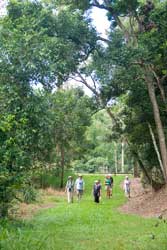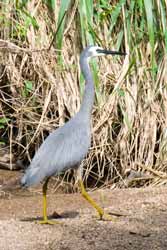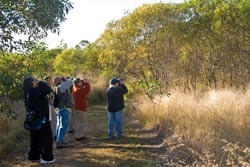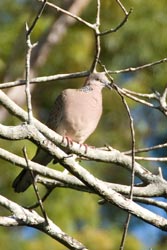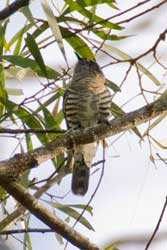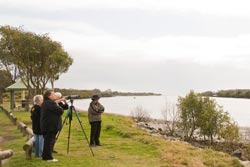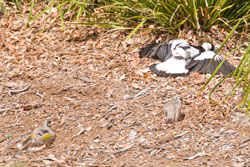Charles & Jenny Ivin Date updated: 14 February 2011
|
Background
BackgroundBirding activities were first carried out in 2008 as part of a comprehensive series of studies of bird life to be conducted along the Brook . Such recorded observations conducted over time allow evaluation of the health and biodiversity of wildlife throughout the catchment. For this reason,our Branch executive decided we should continue a similar series of bird studies along the same lines as the original year. Details of all the studies for 2008, 2009 and 2010 are given in 'News Item - Birds Observations 2010' that can be linked here. Although we have a number of catchment members that are experienced birders, the leadership of Dawn Muir, Birds Queensland, has been vital. She is especially appreciated through the injection of her valuable experience in the conduct of these outings and particularly in their recording. Contributions from Esther Townsend have also been most appreciated. A valuable contribution by Leanne Bowden & Greg Miller, WPSQ Brisbane Branch, with a past reports of one of their walks within the catchment is gratefully acknowledged. Program details for 2011 are available from a small file (PDF, 16 KB). Interested persons should check the latest home page news section to keep up to date on any changes. General precautions to be used during these surveysThese outings need to be carried out in small groups to reduce disturbance of, often, quiet elusive birds. It takes members of reasonable experience to be able to observe and identify birds correctly. However, there has been opportunity for new keen birders to join and learn the ropes on all of our outings. Birders should bring their own personal food and water requirements and sun and skin protection (sunscreen and insect repellant). Although most outings are conducted along made paths, sometimes it is necessary to move carefully into bushland to more closely observe bird movements. Clothes and footwear should be chosen to suit these conditions, where possible. Traveling through natural flora and fauna habitats is usually of relatively low risk (compared with the risk of crossing busy roads) but skin irritations from harmful plants or tick bites can occasionally concern sensitive individuals. Details of observations to dateCassimarty Park and Arbor Park - 6 February 2011Sunday 7 February dawned overcast and extremely humid. Twelve enthusiasts turned up for the survey, including Ray and Di Loughrey from Wahminda Grove Bushcare group. Damage caused by recent heavy rains was evident across the area of the ‘wetland’ in Park and there was creek scouring and bank erosion along Cedar Creek in Cassimarty Park and Arbor Park. Lots of scrub clearing has been done in parts of Arbor Park and small bird habitat diminished. Little birds were noticeable mainly by their absence although we did see some Striated Pardalotes and White-browed Scrub Wrens. A good sighting was made of a pair of Whip Birds cavorting for our entertainment. No raptors were seen, but a good view was had of two Channel Billed Cuckoos flying overhead. Albert Bishop Park and Schultz Canal, then Nundah Lake - 6 March 2011Our group met at Hedley Avenue on 6 March to survey Albert Bishop Park at Toombul and a seaward portion of Schultz Canal. Later, nearby Nundah Lake (UBD map 121 ref D20) was reached by car. We were joined by Jean Weaver, from the Zion Hill Bushcare Group.The morning looked quite threatening with some quite heavy clouds hovering overhead. Despite this, a total of 42 birds were observed, some species of which were seen at both sites. Once again we found only a few ‘little’ birds (e.g. Fairy Wrens). We decided that this was due to several factors namely; recent wet weather conditions, flooding of parts of the survey area. It was also the morning of ‘Clean Up Australia” activities which saw many volunteers scraping/scratching for rubbish in the area. At Nundah Lake, however, there were numerous sightings of Golden-headed Cisticola and Tawny Grassbirds. Wahminda Grove and Maureen Lawrence Park - 3 April 2011 We enjoyed some fine and sunny weather on the morning of our survey, 3 April. However, the previous night had seen some very violent storms in the area with rainfall above 30 mm. The brook was running at fairly full spate, not seen on previous surveys. The number of birds sighted was rather low at thirty species, given previous results. The habitat of the ‘little birds’ had been considerably damaged by the devastating summer in our area. Serious erosion along the creek banks was observed with some quite large trees being uprooted. A group of six enjoyed the morning’s survey activity despite the reduction in species to be expected. Cedar Creek, Upper Kedron - 8 May 2011 The morning began with bright sunshine and cool temperatures but a high level cloud bank later reduced the sunshine periods. However, we enjoyed some excellent birding with 49 species seen over 2.5 hours. The short walk down the bikeway revealed lots of Grey Fantails. Lewin Honeyeaters and a raptor (thought to be a Brown Goshawk). No water birds were observed in the creek north of Upper Kedron Road bridge, but two Pacific Black ducks were seen flying over. On the southern side of Upper Kedron Road we were thrilled to see an Azure Kingfisher, flying down into the creek and landing on a branch near a Pied Cormorant. Later on our return to that area, we also saw a Sacred Kingfisher at the same location – so it was really fascinating to have both the kingfishers and the cormorant on the same branch. At times we were spoilt for choice about where to look as the movements of birds were so prolific. Scarlet Honeyeaters were heard early in the walk, then later sighted, as were the Eastern Whip Birds. Both the Rufous and Golden Whistlers were seen (males and females). Pony Club Bend and Teralba Park - 5 June 2011 We had a couple of visitors from Sydney with us on this survey and they did enjoy the birding. It was most upsetting to see the damage done by recent flood waters, and of course the council's repair work. It would have given home owners quite a fright to see both the amount of water in the brook and the speed at which it was traveling. We were fortunate to observe forty species of birds, but sadly there were very few ‘little’ birds (e.g. wrens). We are hoping they will recover the territory as conditions improve for them. Of special interest was the large number of Northern Mallards seen— which was quite unusual. Grange Forest Park - 3 July 2011 Eight people attended this survey at the Grange on a coolish morning; though it did warm up later. A dead bandicoot was found on the southern bank of Kedron Brook at the end of the holding pond of the stormwater quality improvement system from Alderley Grove. This excited a bit of interest as to the type and cause of death. Nearby, between the holding pond and the Brook, there were pools of brackish water and also a terrible stench; suggestive of some sewerage leakage from a broken concrete structure. Unity Water was advised of this the next morning. Thirty-five species of birds were observed on the day. It was pleasing to see a reasonable variety of the ‘little’ birds. For example, we saw all three varieties of Wrens, Double-barred Finches and some Scarlet Honeyeaters. Bellbird Grove - 7 August 2011 Seven members met at Bellbird Grove at 7.30 am on a mild cool morning. There was some early cloud cover, but the sun broke through later. This was a very interesting survey in that more birds were sighted in the area than we have had before. We visited Bellbird Grove in early September, 2008 with a count of 45 species. Our next visit in November 2009 resulted in 38 species and this was further reduced in 2010 with only 32 species sighted. To obtain a count of seen and heard of 51 species was extraordinary Of special interest was the sighting of the Varied Sittella – first identified by Dawn and Esther by its call, and later observed by all. A look through our records shows that this uncommon species was first sighted in these surveys at Wahminda Grove on 25 November 2008. This was just shortly after the terrible November storms from The Gap through to Ferny Grove when there was a lot of tree damage at Wahminda Grove. Nudgee Waterhole, Kedron Brook Floodway & Nudgee Beach - 4 September 2011 It was a fine, cool, slightly cloudy, morning when six members gathered at the Nundah Waterhole to begin our survey. The waterhole itself had been cleared of much of the green, slimy, growth since the beginning of the year and the tracks in the area had been improved. A good number of water birds were seen at the waterhole; many with young – including the Dusky Moorhens, the Australasian Grebes and Hardheads. At the Nundah Boat ramp, an Eastern Great Egret strolled along the foreshore oblivious to the fishermen and boat launching going on and a pair of Black- winged Stilts worked the lapping edges nearby. A Whistling Kite nest, sighted via telescope on the opposite bank, was observed to have a young bird sitting in it. Moving to the mouth of the Brook, we saw many Rainbow Bee Eaters, Brahminy Kites and Red-backed fairy wrens. Altogether, it was a good morning birding with such a variety of habitats that we were able to sight (and/or hear) fifty-two species. Cedar Creek, Upper Kedron - 17 September Not a KBCB programmed event but one run as a birding outing for Birds Queensland (BQ) so that their members could share an outing within our catchment. Since the observations were carried out over the same area, under the same procedures, the results are of interest for comparison with those of our project. This location has a variety of suitable bird habitats and often has about fifty bird species observed but in this case there were fifty-eight, the highest number we've ever observed at any of our project locations. However, the selection of the date of the walk was not randomised within the method used for the other locations. Thus, there is a possibility there might be an inherent bias so this individual set of results will not be included in the overall analysis of results for this year. Twenty-seven people joined us for this ‘first time’ programmed outing by BQ to Cedar Creek. It was a glorious morning with clear skies and sunshine; although it did get quite warm by mid-morning. There were lots of birds around and some quite exciting sights, including a small flock of over six Topknot Pigeons which flew into a nearby Fig tree. These birds had been sighted flying over on previous occasions, but this was the first time they’d been observed landing in any trees. Superb Wrens, Red-backed Wrens and Scarlet Honeyeaters were plentiful. Another delight was the sighting of a single Northern Mallard up the creek when we crossed the bridge at the half way mark of the walk. There was followed by quite a sudden flurry of Noisy Miners protesting and within minutes they had driven a female Koel away from the area. Members expressed surprise at the number of species sighted in such a small area, and all enjoyed the outing. Whilst we were enjoying refreshments at the end of our walk, our first raptor for the day, a Collared Sparrowhawk, was seen above being harassed by a Torresian Crow. Soon afterwards, barely visible to the naked eye, a small flock of Australian White Ibis was seen 'riding the thermals'. Kalinga and Benelong Park - 2 October On a fine but very blustery morning, five of us set out to complete the survey. It was pleasing to see the Bush Stone Curlews were still on the hill and it looked as though the female was sitting on a nest. Here’s hoping she can raise her chicks despite having to face so many challenges in the area. Only one Corella was seen, despite the fact that at last year’s survey there were several hundred in the playing fields. We were glad to see the family of Superb Fairy Wrens surviving in the matted and weedy location along the western creek edge towards Cressy Wetlands. Of added interest was the sighting of a colony of Little Red Flying Foxes located in trees south-east of the footbridge from the end of Toombul Terrace. Grinstead Park and Sparkes Hill Reserve - 6 November Six of us gathered for our final bird observations for 2011 at Grinstead Park and Sparkes Hill. It was cloudy and humid early on, and quite hot as the cloud was burned away later in the morning. A total of forty-three species were identified. There was much excitement when we sighted three young White- faced Herons sitting under a tree. They appeared to be fledged, but did not yet have full adult markings around the eye. A family of Australian Wood-ducks also presented a ‘not-to-be-missed’ photo opportunity; though these young ones were not quite fully fledged. Of particular note was the large number of Sacred Kingfishers to be seen on Sparkes Hill. There were also several Dollar birds around. Tracking their harsh metallic buzzing calls brought the reward of very positive identification and the satisfaction of watching some diving and rolling display flights. On the way back to near the playground at Grinstead Park, we noticed an Australian Magpie anting itself in the loose mulch. This was despite three Noisy Minors that turned up, not to dispatch the magpie away as usual, but to join in the mulch-rolling activity in warm sunshine together. Lomandra Picnic Area, Samford Conservation Park and Maureen Lawrence Park - 4 October On Tuesday 4 October, our experienced leader, Dawn Muir, led a small group of members of Birds Queensland on one of their programmed bird walks in this area. (included C & J Ivin) The overall walk was sufficiently different from the Wahminda Grove & Maureen Lawrence Park, Samford Rd KBCB survey (see 3/4/2011 walk) that it can't strictly be included in the statistics for the four years series of walks. It mainly differs in that a track was followed eastwards up the ridge from the Wahminda Park that included a sloping area of tall eucalypts and limited understory not representative of the normal area covered. The results are included here because it was clearly within the Kedron Brook catchment and the bird species were similar to those found in the KBCB programmed walks. Highlights near the picnic area included a pair of Pacific Bazas being hassled by the Sulphur-crested Cockatoos and two Brown Goshawks circling high above. Rufous Fantails, White-browed Scrub-wrens, a Leaden Flycatcher, White-throated Treecreepers, a Black-faced Monarch and both Spotted and Striated Pardalotes were a treat to see along the ridge. Detailed resultsResults may be linked from this table as the results of any completed studies become available.
Summary of 2011 observationsDetails of all the studies for 2008 through to 2011 are given in the table, 'Table 1 KBCB_WPSQ Results of Bird Studies 2008 - 2011, Summary of study dates, location codes, actual locations and conditions'. This is a small pdf file. Each study location code consists of an acronym of the location name together with a four numeral bit that represents the month and year. Thus, the code, 'FG-AP-BCP-0810', represents Ferny Grove, Arbor and Bob Cassimaty Parks specifically as conducted in August 2010. A statistical analysis of all of the 2011 bird observations was carried out in a similar manner to that conducted for the previous years using Microsoft Excel worksheets and suitable pivot table analysis to obtain summary information about the surveys. The bottom section of Table 1 contains the 2011 location codes with details of their location, the date of survey, conditions and leader. The location code is needed to assist the interpretation of the next table entitled, 'Table 2 - KBCB-WPSQ - Common name of bird species found at given coded locations for bird observations at the eleven surveys conducted for 2011- Alphabetic name order'. In column one, the common name of the specified bird as specified by Christidis & Boyles (C&B) is given in alphabetic order down the table. A numeral '1' in the column below any given location code indicates that at least one bird of the species named for that row was observed (or heard with the specific characteristic call) for that location. As an example of the use of this 'Table 2', the fifth column with the 'FG-AP-BCP-0211' location code represents the survey conducted at Ferny Grove, Arbor Park, and Bob Cassimarty Park in February 2011. The top two rows down for that particular column indicate that there weren't any Australasian Grebes or Australian Brush-turkeys observed but the next row down indicates that the Australian Figbird was observed for that survey, and so on. The companion table, 'Table 2S - KBCB-WPSQ -Common name of bird species found at given coded locations for bird observations at the eleven surveys conducted in 2011- Seq order' gives virtually the same information. However, the rows are sorted in a different sequence based upon that given down the 'Qld' column of the 'Australian bird list by state' spreadsheet, as obtained from the Birds Queensland web site. The latter information in turn is based upon the original authorative reference by Christidis & Boyles (C&B). Serious birders generally use this ordering method based upon the C&B listing sequence since the resultant order of birds in column one is then based upon a scientifically accepted sequence of names of genus and species for birds. (Note that 'Seq' number used for these KBCB bird listings has nothing to do with the 'Atlas number' used in some other bird lists that, for example, might be used by possibly a member of Birds Australia, or other birding organisations.) Additional statistics determined from these records are being examined and results will be included here as time permits. ContactFor any queries relating to these birding walks, please contact Outing Coordinator, Jenny Ivin, on phone 3851 0160 or for further information. |
CI 14/02/2012

